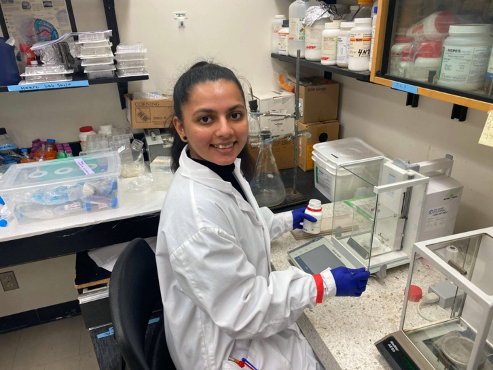Neuropharmacology Lab 101
Author: Fahed Abu-Hijleh
Hello friends! My name is Fahed Abu-Hijleh, and I am a PhD student in Dr. Ram Mishra’s lab. We are a neuropharmacology lab – we study how drugs affect the nervous system. As the pandemic makes it difficult to experience different lab settings, I’m going to describe some techniques we use in our lab.
Skill #1. Making Solutions:
Making solutions is the first and most important thing one must master when working in a lab that studies drugs! You must be able to calculate and create solutions with the required concentration. For those unfamiliar with making a solution, you take solutes (for example, lithium chloride) and dissolve them into a solvent (usually water or phosphate buffer solution). Concentration is the "amount per volume" and can be represented in many ways; however, commonly, we report molarity (chemistry 101). What's most important is that you make the right solution concentration needed for your experiment.

Skill #2. Growing Neurons, aka Cell Culture:
Cell culture is essentially removing cells (in my case, neurons) from an animal (typically a mouse or rat) and growing them in a favourable artificial environment (this is routinely achieved through the use of an incubator). An incubator creates an environment which mimics the host’s body by maintaining a set temperature, humidity, and CO2 level. In the case of neurons, we incubate at high humidity levels, at a temperature of 37°C, and at 5% CO2. Cells are grown in flasks containing "growth media" which supplies the cells with various nutrients including amino acids, glucose, salts, and vitamins. Most mammalian cell lines also require "serum" extracted from animal blood, which is basically a combination of growth factors and hormones. Above all, it is imperative that you practice proper sterile techniques as cell cultures can easily become contaminated. If an environment can support human cells, it can definitely grow bacteria. Once the cell culture is ready, we are able to do the exciting part; treating the cells with drugs and assessing cell viability and changes in gene expression!


Skill #3. Measuring Gene Expression, aka Real-Time PCR:
Hopefully, we all know what the central dogma of molecular biology tells us; the instructions of life are written in the DNA and eventually converted into proteins that serve as functional products. For example, the human insulin gene, "INS”, is transcribed into messenger RNA (mRNA) and then translated into the actual insulin protein. This process is true for almost every protein in our body.
When studying drugs, we usually hypothesize that the changes in a cell's behaviour are due to an increase or decrease of a specific gene or group of genes. The easiest way to measure these changes is by using a Nobel prize-winning technique, polymerase chain reaction (PCR). This technique allows us to amplify a unique sequence in the DNA. The sequence is targeted with short, single strands of DNA, called primers, which are designed to match and bind to each end of the target sequence. Based on the amount of DNA you amplify, you can determine if is more or less of a specific gene between two samples. While this may sound complicated, believe me, like anything, it is a learnable skill!

Conclusion:
If you can master these three skills, you will have no problem working as a molecular neuroscientist in our lab (or probably any)! You can learn these skills even without a background in biochemistry; all it takes is dedication and a desire to learn. Feel free to reach out if you want to know more or have questions!